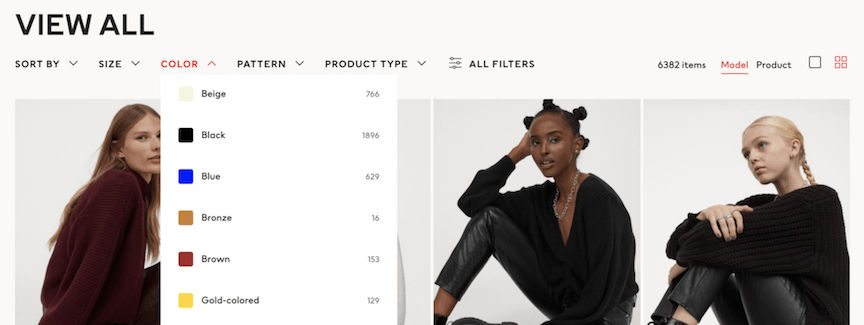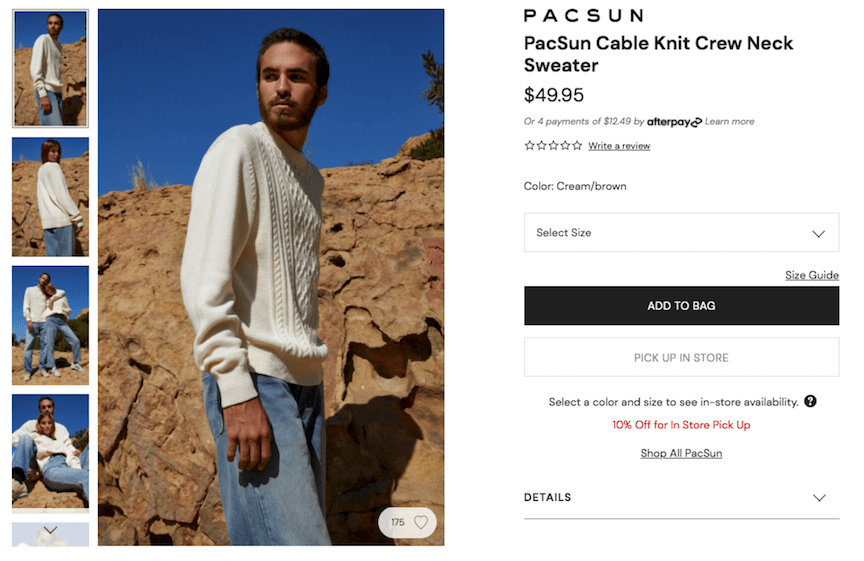Ecommerce accounted for over 14% of retail sales in 2019, and that percentage is projected to increase over the coming years. If you’re looking to get in on the ecommerce action, you need to make sure your website has the ecommerce essentials it needs to succeed.
That’s why, in this post, we’ll go over 11 ecommerce website essentials!
Want expert assistance building your ecommerce website, driving site traffic, or increasing conversions? Explore our ecommerce web development and marketing services and request a free quote today.
Partner with Ecommerce masters!
Campaigns managed by WebFX have earned over
9000000
TRANSACTIONS IN THE LAST 5 YEARS
Read Case Studies
1. Mobile-friendly design
Did you know that more than half of all website traffic now comes from mobile devices, and 61% of consumers are more likely to buy from mobile-friendly sites? That means making your ecommerce website mobile-friendly can increase both your traffic and conversions!
To make your site mobile-friendly, use responsive web design. Responsive websites adjust to the screen on which someone views them, so your site looks great and works correctly on laptops, tablets, and smartphones.
2. User-friendly navigation features
If users can’t quickly find what they need on your ecommerce site, they’re unlikely to stick around long and even less likely to make a purchase. Helpful, easy-to-use navigation is one of the most essential ecommerce website features.
Have clear menus that allow users to browse different product categories. Make sure these menus are in easy-to-find locations, such as across the top of every page.
![Horizontal ecommerce menu on Overstock.com]()
You can also allow users to filter and sort products by price, style, size, manufacturer, and other characteristics. The features you include depend on the products you offer and the characteristics that are important to your customers.
![Ecommerce navigation filters on H&M's website]()
3. Security features
One of the most important ecommerce website essentials is adequate security. You need to protect your customers’ data, and you need to show visitors that your site is secure and trustworthy.
If shoppers don’t trust your site, they likely won’t make a purchase. Insufficient security also opens your business up to significant financial and legal risks.
Some of the most vital site security steps include:
- Purchasing a Secure Sockets Layer (SSL) certificate, which enables your site to transmit data securely
- Using an address verification system (AVS) and credit card verification value (CVV) at checkout
- Creating secure passwords and updating them regularly
Read through our entire site security checklist to learn more.
4. Prominent shopping cart and checkout buttons
Easy-to-use cart and checkout features are two more essential ecommerce websites features. To encourage conversions, make sure your ‘add to cart’ and ‘check out’ buttons display prominently on your site.
When the user clicks into their cart, show them all the relevant details, such as the name, price, and quantity of each product in their cart. Shoppers should also be able to remove items or change item quantity directly from their cart.
Also, allow customers to save their cart so they can come back to it later.
![Kohl's ecommerce cart checkout button]()
5. Several payment options
The way you accept payment is crucial for every business, including ecommerce websites. Allowing as many popular payment options as possible improves your customers’ experience and can encourage conversions.
In addition to major credit cards, consider accepting payment methods such as PayPal and Apple Pay. Display icons of accepted payment methods on your site so shoppers know in advance what they can use to buy your products.
6. High-quality photos and videos
Visual content gets users’ attention, keeps them engaged, and helps them make purchase decisions. Using high-quality photos and videos on your site makes you look professional and improves user experience.
Studies have even suggested that product videos make shoppers 85% more likely to purchase a product.
Don’t just settle for one image of your product either. Include photos from multiple angles, let shoppers zoom in on the image, and show people using the product in different situations.
![Sweater product images on PacSun's website]()
Make sure, though, that your visual ecommerce website elements don’t cause your pages to load slowly. Page speed optimization techniques and services can help you avoid this issue.
7. Detailed shipping and return information
Providing detailed shipping and return policy information can help shoppers feel more comfortable about making a purchase, which increases conversions.
Make your shipping information and return policy easy to find and easy to understand. Your website’s footer is an excellent place to put links to this information.
Offering a generous return policy and free or low-cost shipping can increase your conversion rate.
8. Ratings, reviews, and other social proof
Do you read online reviews before you make a purchase? So do 95% of customers. And, more than 70% of users won’t make a purchase until they’ve read reviews, making ratings and reviews one of the top ecommerce website essentials.
Including user-generated ratings and reviews on your website can help keep shoppers on your site and encourage them to make purchases. To get reviews, build review functionality into your site and encourage customers to leave reviews on third-party sites like Google My Business, Facebook, and product review websites.
Other kinds of helpful social proof include user-created social media content and testimonials.
9. Item availability
Few things in online shopping are more frustrating than deciding on a product — or even making a purchase — only to discover that the item you want is out of stock. You must reevaluate your purchase decision or wait an unspecified amount of time for the company to restock.
Help your customers avoid this frustration by making the availability of each product prominent on its product page. If an item is out of stock, include information about when it will be available again.
10. A frequently asked questions (FAQ) page
A well-thought-out and easily accessible FAQ page can help make users’ experience on your website much more convenient. If users have a question, a FAQ page can help them find the answer quickly.
When first creating your FAQ page, brainstorm questions users may have, think about questions you often get, and consider whether there’s anything you want users to know that would fit well on the FAQ page.
Later, if you find customers often ask a question that isn’t yet on your FAQ page, add it in.
comcast
-9
industry average
16
apple
72
webfx
76
11. A contact page with multiple contact options
If users can’t find the answer to a question on your FAQ page, they may want to contact you. An easy-to-find contact page with several contact options makes your site more user-friendly and helps your business appear trustworthy.
On your contact page, include contact options such as a phone number, an email address, and social media profiles. You can also use a chatbot to answer users’ questions and help them get in contact with the right members of your team.
Ecommerce website essentials and beyond from WebFX
Does your website have all the ecommerce essentials? If not, add these ecommerce website elements to your site so you can start pulling in more customers and driving more sales.
For more ecommerce tips, check out our other ecommerce resources.
If you’d like help getting your ecommerce website up and running or taking your ecommerce business to the next level, consider our ecommerce website development and ecommerce marketing services. Request a free quote online or call us at 888-601-5359 to get started.
The post Ecommerce Website Essentials: Does Your Site Have All 11? appeared first on WebFX Blog.
The overall quality of a website’s design is often in the details. Those seemingly-small elements such as microinteractions, typographic spacing and color accents can be real difference makers. They have the potential to transform the mundane into something that stands out.
In these cases, being picky about design is a good thing. Whether that trait comes from you or your client, the goal is the same. It’s all about improving the look, the intuitiveness and, ultimately, the user experience.
As honorable as that may sound, it’s worth wondering: is there a point in a given project where pickiness becomes a liability, rather than a benefit? Can obsessing over every last detail actually cloud the bigger picture?
In my opinion, design focus can indeed be done to death – or at least to the detriment of a project. Let’s outline a few situations where the process can get in the way.
The Web Designer Toolbox
Unlimited Downloads: 1,000,000+ Web Templates, Themes, Plugins, Design Assets, and much more!
When Design Elements Turn Overly Complex
Sometimes the focus on detail can take us to a bad place – one where bells and whistles overtake usability. The result is a feature that may look really cool, yet be difficult for the end user to figure out. In some cases, it may not even be relevant to what you’re trying to accomplish.
This is one of those classic cases of web design gone too far. We saw it a lot in the days of Flash, where high-tech splash animations were used by everyone from gas stations to law firms. Once the novelty wore off, these sorts of features were merely obstacles for users to navigate.
The modern web has its own vices. Distracting video backgrounds and purposeless hero images take up valuable screen real estate and can make it more difficult for users to get the information they need. That’s not to say these features have no place in web design – just that there’s the potential to go over-the-top with them.
Plus, pouring a lot of time and effort into these elements doesn’t guarantee effectiveness. They still need to have a purposeful existence and be easy to use. Design should be there to help simplify them.

When Time and Budget Are Limited
Web designers are often saddled with the responsibility of getting projects done within tight budgets and deadlines. We’re pros at putting it all together. But a micro-managing client can stall progress significantly.
Make no mistake, clients are entitled to make changes – and their opinion counts. Still, there are occasions when one gets so hung up on a particular item that it throws the entire project status into question.
This is certainly understandable when it comes to major features. All stakeholders want to make sure that things look and function according to plan – and good things do often take time. It’s part of the due diligence that comes with building a website.
But these issues also tend to pop up over the most minute details. And they are often a matter of personal preference. For example, insisting that a button look and function exactly as it does on a competitor’s site, if only for the sake of one person’s ego.
In a perfect world, we’d have all the time and budget needed to go down this rabbit hole. But in reality, this can take valuable human resources away from other critical areas that need to be addressed. Things must be prioritized in order to ensure progress.

When It Leads to Constant, Counterproductive Change
The design process can often be iterative, where things are improved upon over time. This happens as we become more aware of how visitors are actually using the things we create. They help us to understand their pain points so that we can refine them.
Therefore, change is to be expected. But if things change too dramatically it can backfire. A sudden change to the UI, for instance, might confuse visitors. They have to relearn their how to do what they want – or simply move on to a different site.
Amazingly, this strategy seems to be employed by some big brands. As of this writing, PayPal is a prime example. Their account management UI changes more often than the weather. It seems like every time I log in things are significantly different. Maybe there’s a method to this madness, but it feels more infuriating than useful.
Of course, techniques such as A/B testing are very much viable. But there’s a difference between making slight changes for the sake of conversions and obsessing to the point where you can’t make up your mind. Without at least some consistency, the user experience is bound to suffer.

Attention to Detail Is Great. Obsession? Not as Much.
Every website needs to have an end goal. Perhaps it’s making an eCommerce sale or getting a user to reach out and contact you. Whatever it is, the site’s design should be focused on achieving the desired result.
But, as we are only human beings, that laser-like focus can be incredibly difficult to attain. Instead, stakeholders can obsess over design to the point where it does more harm than good. That could mean missing out on deadlines or busting the project’s budget. It might even result in an end product that’s not as user-friendly as it could be.
With that, there’s certainly a case to be made for slowing down the design process. Ideally, it gives everyone room to breathe and create the best possible outcome. That is, as long as the time is used wisely.
All stakeholders should focus on the details – just not at the expense of the stated goals.
The post At What Point Does Obsessing Over Design Become a Liability? appeared first on Speckyboy Design Magazine.












